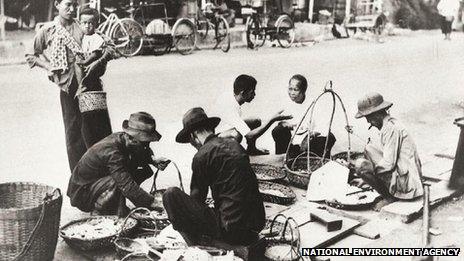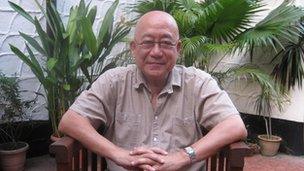Why are there hawker centres in Singapore?
- Published

Early hawker centres were simple but included basic amenities
Singapore's food courts, known locally as hawker centres, are popular with locals and tourists alike. But it all started when Singapore's migrants took up hawking in the 1950s and 1960s, and the government became concerned about hygiene, the former Public Health Commissioner Daniel Wang tells the BBC's Helier Cheung.
Singapore's hawker centres started partly for hygiene reasons, and to keep our water pollution in control. Singapore's street hawkers were polluting the water courses quite badly. We had a major problem with water pollution.
So we decided to relocate the street hawkers - putting them in hawker centres, with proper sewers, and providing them with basic amenities, like water, electricity, fridges, lighting and so forth.
Back when I first became public health commissioner, in 1979, the conditions were quite bad. The drains were all polluted, hawkers used basins to wash their soiled crockery, and you could see rats, cockroaches, and other animals running around.

Many took up street hawking as a livelihood in the 1950s and 1960s
At the time, people just accepted it because there was no alternative. In fact, when we moved street hawkers into hawker centres, initially, there was some criticism that the food was not as tasty anymore, because it was too hygienic!
I noticed that there were spittons under every table in the coffee shops - I had to put a ban to that and tell people you have to spit into your handkerchief and deposit it into a waste bin.
Also, I noticed that a lot of coffee shop food handlers would wear pajama pants, which were very untidy, so I said no more pajamas were to be worn.
I was told the reason why they were given pajama pants was because the pants had no pockets, so whatever money they got from the customers they had to pay to the cashier. But you know when you move around wearing pajama pants, you tend to forget that you didn't just get out of bed!

Daniel Wang was responsible for relocating thousands of street hawkers
Initially we had to register all the street hawkers, and find a site near where they were operating [to relocate them to]. We had to give them an assurance that after they'd been relocated, no street hawkers would go back to their old spots.
All the assistants and food handlers would have to go through a basic hygiene course, and at the end of the course they had to sit through a small test to become a registered food handler.
Most of them passed the test first time - it covered common sense things like washing your hands before handling food.
We also decided to rate the hawker stalls for cleanliness and food handling, from A to D. If you reach D it means you've been suspended.
Eventually we noticed that hawker centres have become some kind of social gathering place where family and friends come. We didn't anticipate that that would take place [when we set up the hawker centres], but it turned out really well.
For me, the most interesting aspect of my work was the opportunity to see Singapore transform from a poor, underdeveloped state back in 1969 to [the developed city] it is today.